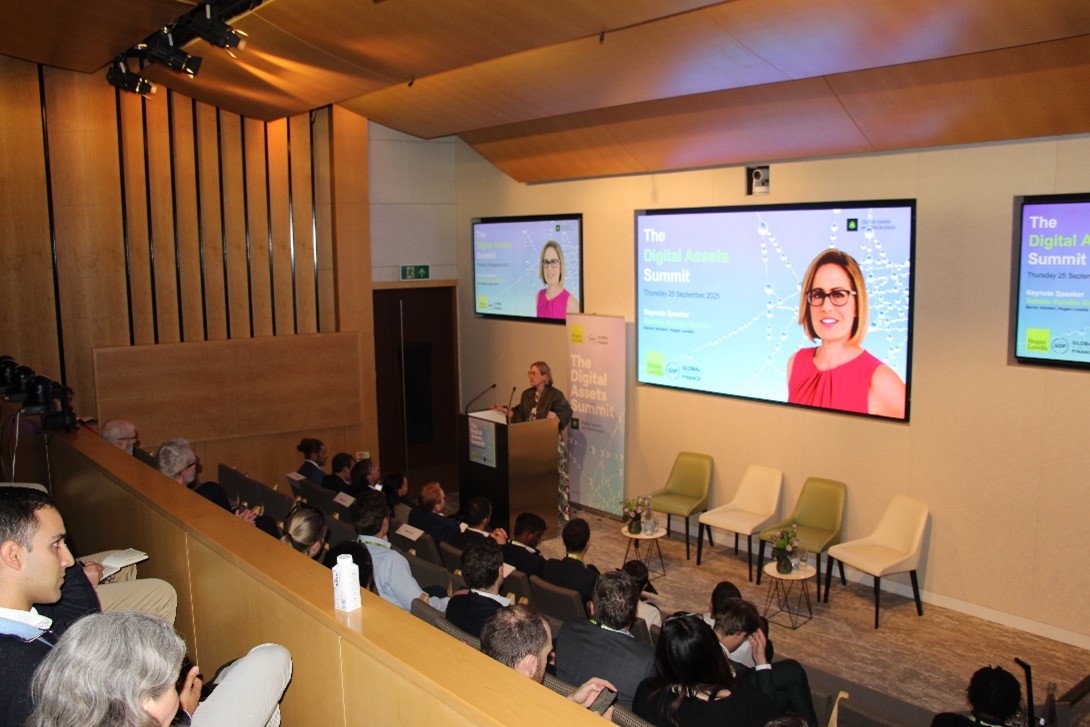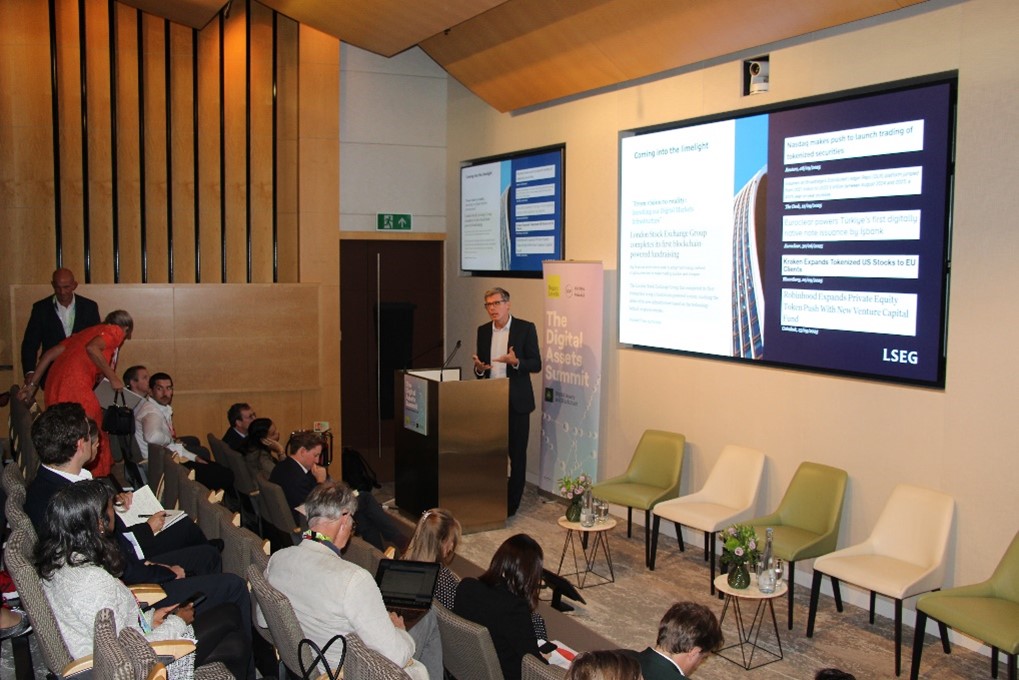
Panoramic: Automotive and Mobility 2025
 Search
Search


 Search
Search

On 25 September 2025, we gathered financial institutions, policymakers, innovators and market players, and Hogan Lovells Partners to our London office (in-person and virtually) for our 6th annual summit on digital assets, held in partnership with Global Digital Finance. This year, the theme of our summit is Winds of Change, focusing on global policy and regulatory shifts in approaches towards digital assets in financial services.
With over 300 attendees (155 in person, 165 virtual) and 19 expert speakers, the Digital Assets Summit delivered a powerful day of insights and global perspectives on the future of finance.
We were honoured to be joined by Krysten Sinema, former United States Senator and Senior Advisor in Hogan Lovells’ Government Relations and Public Affairs practice, to deliver the opening keynote speech, setting out the radical change in the US political and regulatory landscape as it pertains to digital assets since the advent of the Trump administration as a significant backdrop for the subsequent panel discussion.
Key drivers of change include the pivot in the SEC’s approach, the appointment of David Sacks as White House AI and crypto czar to coordinate action across the different US agencies that were historically siloed, as well as bipartisan efforts to legislate for payment stablecoins and the ongoing initiatives to legislate for cryptoasset market structure. The policy message is clear—the US is open for crypto business.

Picture: Kyrsten Sinema, Senior Advisor at Hogan Lovells.
We were delighted to have Darko Hajdukovic, the Head of Digital Infrastructure for the London Stock Exchange Group (LSEG), deliver our second keynote of the day. Darko invited us to view Distributed Ledger Technology (‘DLT’) as more than just a database that exists across several locations or among multiple participants, but as a technology that allows us to reimagine capital markets, with the aim of addressing some of the major market inefficiencies we are experiencing today.
Achieving interoperability of between various blockchain solutions is a long-term goal in order to achieve scale in the institutional adoption of DLT, we need to focus on finding a way to connect traditional finance with digital finance in the meantime. Crucially, Darko emphasised the need to identify and advocate for a business rationale to transition away from legacy systems to implementing DLT solutions – this could include, for example, potential positive impact on liquidity, lower transaction latency, improved security, increased opportunities for raising capital, better data quality, as well as reduced costs. Darko highlighted the LSEG
Workspace, a financial and market intelligence platform by LSEG, as a useful tool in this regard to demonstrate – using financial markets data and analytics— the opportunities offered by DLT.

Picture: Darko Hajdukovic, Head of Digital Markets Infrastructure at London Stock Exchange.
Hogan Lovells Partner Michael Thomas led the panel discussion on the digital asset regulatory landscape. The panel included Jane Moore, Head of Department, Payments and Digital Assets at the Financial Conduct Authority; Giuseppe Ciallella, Senior Legal Counsel and Manager at the Bank of England; Wijitleka Marome, London Chief Representative of the Bank of Thailand, and Lavan Thasarathakumar, Senior Advisor at Hogan Lovells.
The panelists discussed efforts that have been made towards developing a globally convergent approach to the regulation of digital assets, noting the central role of international standards such as recommendations by the Financial Stability Board in relation to stablecoins and IOSCO’s policy recommendations on the regulation of crypto and digital assets. Yet there are a number of pressures driving divergence between jurisdictions, from varying political priorities to contrasting risk appetites. Notably, given the scale of the US economy, recent developments in the US inevitably carry implications worldwide.
From a regulator and policymaker’s perspective, the key is to balance considerations around financial stability and consumer protection, against facilitating an open and competitive digital assets landscape within their jurisdictions. Cooperation with market participants is vital to getting this right. The panelists highlighted the value of industry input to regulatory consultations as well as learnings arising from regulatory sandboxes, such as the Digital Securities Sandbox and the FCA’s Innovation Hub, the EU’s DLT Pilot Regime, and Bank of Thailand’s Regulatory Sandbox for programmable payments. Overall, there was excitement over what is yet to come, from stablecoins and tokenized deposits, to innovations in central bank money and modernization of the RTGS.

Picture from left to right: Michael Thomas, Giuseppe Ciallella, Wijitleka Marome, Lavan Thasarathakumar, Jane Moore (on the screen).
To provide a broad picture of digital asset development, Hogan Lovells representatives from nine different jurisdictions and the EU provided an overview of the regulatory direction and market sentiment in their respective regions. With input from Washington D.C. to Hong Kong and Rome, this global roundup highlights a wide range of approaches, initiatives, and concerns in relation to crypto, tokenization, and digital bonds.
The key theme that emerged from the 10 reports was that countries are taking one of two approaches to digital assets. On one side are those looking to build regulatory frameworks focused on fostering innovation and encouraging the use of digital assets. The US is leading this approach, with the UK in particular appearing to follow suit. On the other side are those who are more wary of the potential risks of digital assets and are building more restrictive regulatory regimes with the intention of providing more protection for consumers. At the head of this second approach is the EU, with member states demonstrating varying levels of adherence to this view.
Sara Lenet, Washington D.C., built on Kyrsten Sinema's comments regarding the US, explaining that the administration's current aims are to provide regulatory clarity. The intention is that having more regulatory certainty will encourage more market innovation, thereby keeping the US as the world leader in the digital assets space. There are legislative initiatives intending to achieve this by clarifying the federal regulatory scheme(s) and boundaries for digital assets-related activities. Signing the GENIUS Act into law in July 2025, which excludes GENIUS Act-compliant stablecoins from securities laws and establishes their own federal regulatory framework, was the first step; more legislation and regulation is expected over the coming months to address topics including market structure, digital commodities, regulator jurisdictions, banking, illicit finance, and taxation.
Andrew McGinty, Hong Kong, reported on the major updates from across Asia. There has been a recent flurry of policy announcements and legislation in the digital assets space, but the competition to be the main Asian hub for digital assets remains primarily a tussle between Hong Kong and Singapore. A key development is Hong Kong's Stablecoin Ordinance, which took effect from August 1, 2025, and creates a regime that captures a wider range of transactions than the 2023 equivalent in Singapore by encompassing fiat-referenced stablecoins that are (i) issued in Hong Kong, (ii) pegged to the Hong Kong Dollar, or (iii) actively marketed to the Hong Kong public. The Stablecoin Ordinance further mandates licensing, reserve asset, and redemption right requirements. There is also a consultation going on with legislation expected in 2026 to create a licensing regime for platforms facilitating OTC peer-to-peer transactions in digital assets and digital asset custodians. However, banks across the region remain cautious about stepping into the custody space due to questions around market size and risk. Geopolitics are a significant factor in the region, with China being opposed to the use or trading of crypto in China but supporting other digital asset development such as CBDCs (where its roll out is probably the most advanced worldwide), while the US is strongly advocating in favor of crypto and opposed to CBDCs. Hong Kong, as a Special Administrative Region of China, will always have to walk that tightrope when seeking to become the digital asset (including crypto) hub for Asia. The hope is that the Hong Kong Government Policy Statement 2.0 and LEAP framework, developments in digital bonds – Hong Kong has now issued two digital green bonds and launched the sandbox in August 2025 to facilitate institutions settling using tokenised assets – will develop new use cases, stimulate positive market sentiment and lead to more infrastructure development and that a more supportive environment in the US for digital assets will stimulate jurisdictions in Asia to up their game to remain competitive.
James Sharp, London, set out the "cautiously optimistic" mood regarding the UK outlook despite some concerns around whether the UK will grasp the opportunity to lead on digital assets and particularly stablecoins. There have been positive signs with the UK and US engaging on digital assets opportunities, and earlier this week announced a transatlantic digital asset taskforce which will deliver recommendations for alignment within 180 days. Domestically, the FCA published its cryptoasset regulatory roadmap in November 2024, under which complete rules are to be finalized in 2026, while HM Treasury has published legislative plans to bring "qualifying cryptoassets", "qualifying stablecoins" and certain related activities within the remit of the existing FSMA regime, as well as outlining ambitious plans to digitalize wholesale financial markets using DLT. There has also been further exploration of a CBDC with the launch of the Digital Pound Lab, and progress towards tokenizing government gilts through the DIGIT initiative. This time next year we should have a clear picture of what the UK regulatory regime will look like, and applications should be under review at the FCA.
Lavan Thasarathakumar, London and Brussels, gave an overview of the EU position. The shift in US policy has raised concerns in the EU as to whether it needs to re-evaluate its own approach, particularly in relation to EU strategic autonomy. This has resulted in questions around (i) whether MiCA is fit for purpose and (ii) whether this strengthens the need for a Digital Euro. Whilst MiCA is being implemented across the EU, fresh concerns have emerged around passporting and a recent letter penned by the AMF, CONSOB and the Austrian FMA has threatened to prevent this, and has also ignited discussions on ESMA being the authoriser for CASPs. Meanwhile, the EU is looking to improve on the DLT Pilot Regime, which is under scrutiny for only having two entrants. Discussions are underway taking into the considerations from ESMA. Looking forward, tokenization will play a key role in the future of the EU as it is seen as a means of unlocking large amounts of capital and delivering on the Savings and Investment Union (SIU).
Ariane Mehrshahi, Luxembourg, reported that there is "lots of momentum" in the digital assets space in Luxembourg. The existing legal framework for digital securities (in dematerialized form) has been further developed by (i) adding the position of control agent as an additional alternative to the CSD or the central account keeper—simplifying the custody chain and reconciliation—and (ii) extending the scope of this law to equity and investment fund units. The funds industry already uses tokenized instruments (in registered form), and this year, the first fully tokenized UCITS on a public blockchain was launched. The adjustment to the legal framework for digital securities in dematerialized form will also give the fund industry access to this framework and boost tokenization and the use of DLT. Numerous MiCA/Crypto Asset Service Provider licenses are being issued by an active and engaged local regulator. A new Luxembourg CSD using DLT is expected to be licensed soon, which will make Luxembourg digital securities eligible for real trading on the Luxembourg Stock Exchange. Luxembourg is keen to maintain the momentum.
Vincent Fidelle, Paris, described the situation in France, where there are concerns around the international development of digital asset regulation. On a regional level, the French regulator is concerned about how MiCA is being applied in jurisdictions such as Malta. On a global level, there is concern around the growth of dollar-backed stablecoins (which is likely to grow with the GENIUS Act being passed) due to the need to acquire dollars to back these stablecoins worsening France's public finances, and that stablecoins threaten monetary sovereignty if they replace central bank currency and the bank loses control. Hence, France is in agreement with the EU's push to create a CBDC. While the EU's DLT pilot regime is welcomed in France, the lack of interoperability with legacy systems, and the absence of integrated, trusted mechanisms for cash settlement means that most bond issuance experiments take place outside of the pilot. The Banque de France will continue work on CBDCs and cash settlement with the aim of increasing digitalization, but no timelines have been set for this.
Philip Van Steenwinkel, Brussels, commented that Belgian financial institutions have been more vocal about their interest in the digital asset space over the last year. This is supported by the implementation of MiCA, and introduction of a "digital assets" concept in Belgian civil law. However, some in the market would welcome further regulatory guidance, and opportunities to discuss projects and points of relevance with the regulators; although, the more hands-off approach by the Belgian regulators creates opportunities for some participants to innovate without too burdensome regulation and has led to a generally positive sentiment towards the outlook in Belgium.
Jochen Seitz, Frankfurt, reported that Germany has made progress in the crypto and digital bonds spaces. Regarding crypto, the transposition of MiCA into German law has recently concluded, despite some delays, and the new Crypto Markets Supervision Act is in force. BaFin has recently issued a series of MiCA licenses, signalling Germany's entry into this space. Regarding digital bonds, participation in the ECB trials and the Bundesbank's unveiling of the Trigger Solution (which provides interoperability in TARGET2) has given momentum to DLT transactions in Germany. Looking forward, growth and innovation in digital assets is expected to continue. Particularly, in the market infrastructure space new players are emerging with innovative DLT-based market models the acceptance of which will still need to be tested.
Eoin O'Connor, Dublin, highlighted that the Central Bank of Ireland's MiCA approval process is a focus for the crypto industry in Ireland. The comments from France regarding prohibiting Crypto Asset Service Providers authorized in certain EU member states from passporting raised concern in Ireland, as a significant financial service exporter. There is a sense that the Central Bank of Ireland has turned a corner on MiCAR implementation, with applicants praising the quality of recent engagement on applications and the Central Bank’s approach to industry engagement.
Elisabetta Zeppieri, Rome, explained that the focus on Italy is moving from the pre-existing domestic regime to the MiCA regime. The transitional regime for Virtual Asset Service Providers has been extended such that firms must submit a MiCA application by the end of the year and may continue to operate under the old regime until June 30, 2026. The Italian regulators are currently holding pre-filing meetings to assist with these applications and it is expected that the first Italian Crypto Asset Service Providers will be authorized in the near future. On the DLT side of things, Italy has implemented the EU DLT Pilot Regime, with four entities currently involved and further applications being assessed by the regulators.

Picture from left to right: Sharon Lewis, James Sharp, Lavan Thasarathakumar, Ariane Mehrshahi, Vincent Fidelle, and Sara Lenet (on the screen).
Hogan Lovells Partner Bryony Widdup led an engaging discussion on the digitalization of capital markets. The distinguished panelists included Barnali Biswal, CEO at Hilbert Group; Emma Lovett, Executive Director, Markets Digital Assets at JP Morgan; Ryan Hayward, Head of Digital Assets and Strategic Investments at Barclays; Quentin Werlé, Head of Portfolio Management at 6 Monks; and Mark New, Co-Head of Digital Transformation and Senior Counsel at ISDA.
The discussion highlighted the market's transformation in terms of asset and collateral tokenization and the development of new on-chain cash-leg solutions. The sense is that we are at the “end of the beginning” in terms of progress and that there has been a significant acceleration of activity and scale in the last 12 months. Activity around evolving DLT use cases for derivatives and intraday repo were particularly emphasized, with the advantages of instantaneous technology-based DvP in on-chain transactions being a key feature. Moreover, public blockchains might offer solutions to liquidity and interoperability challenges and as authorities were now taking a more positive view of this technology, it was likely to shape future direction.
Despite some ongoing difficulties in designing and delivering products that engender trust and comply with existing institutional processes including compliance and KYC, the panel noted that emerging regulatory clarity provides an opportunity to build resilient, long-term, end-to-end solutions for a mature, investment-grade market. The regulatory landscape in Europe, including from a Luxembourg alternative funds perspective, represents a strong foundation for growth in the digital assets investment management and funds space. It was expected that in the near future, US asset managers looking for distribution routes into Europe would use traditional routes, including Irish and Luxembourg based structures and regulated entities, to grow their cross-border business.
Industry bodies like ISDA play a vital role in co-ordinating standards and market participant activities in this area and will continue to support the development of safe and efficient markets by setting high standards and shaping shared expectations, including through the standardization of legal frameworks, contractual documentation and definitions, and shared data models such as the ISDA common domain model. The ability to role out common approaches to solve uncertainty and implement solutions is further enhanced by working together in cross-collaboration with others, like ICMA and Global Digital Finance, in open discussions and working groups that are becoming increasingly deep and granular on real world, scaled transaction implementation.

Picture from left to right: Bryony Widdup, Quentin Werlé, Emma Lovett, Ryan Hayward and Barnali Biswal.
Hogan Lovells Partner and Co-chair of the Digital Assets and Blockchain Practice, John Salmon, moderated an insightful panel discussion on the future of digital payments. The discussion featured prominent voices including Elise Soucie Watts, Executive Director at Global Digital Finance; Will Paul, Global Head of Payments, Hardware and Small Business Public Policy; Richard Crook, CEO at Deus X Pay; and John Whelan, Managing Director (Digital Assets) at Santander.
The panel highlighted that payment innovation is currently a hot topic across industries, central bankers, and policymakers worldwide. The panellists discussed the increasing interaction between stablecoins and traditional market players, and the lingering trust barriers to the adoption of programmable payments. Business leaders within financial institutions will need to recognize that new payment technologies may cannibalize existing revenue streams and incumbent business models for innovation to truly thrive.
Other significant drivers shaping the payment landscape include the growing volume and size of payment transactions and a complex political backdrop. The policy approach and regulatory objectives regarding payment instruments and systems vary across jurisdictions. In simple terms, the US has prioritized stablecoins with the passing of the GENIUS Act; EU leaders are championing the digital Euro; while the UK is pushing forward with RTGS upgrades and encouraging the development of tokenized deposits.
The panellists also discussed the progress of payment innovation in the context of the consumer experience, noting the importance of consumer-centric applications along with developments in AI, and the role of regulation in ensuring the safety of new technologies and fostering trust.
Looking ahead, as the internet of value continues to mature—potentially requiring two more decades to reach the same level of maturity as the internet of information—we can expect rapid growth of new technologies and novel ways of transferring value. Agentic AI is likely to play a pivotal role. Ultimately, payments will remain a fundamental part of a functioning, growing economy, even 100 years from now. In the meantime, the development of proportionate regulation will be key to having an inclusive system that can be used by all generations.

Picture from left to right: John Salmon, Richard Crook, Elise Soucie Watts, Will Paul and John Whelan.
To close off the day, Hogan Lovells Partner and Co-chair of Digital Assets and Blockchain Practice Sharon Lewis was joined by Lawrence Wintermeyer, Chair at Global Digital Finance, and Niki Beattie, CEO of Market Structure Partners and Chair of ClearToken.
The panel reflected on the rapid evolution of the global digital assets markets, from the shifting global political landscape driven by the US, to the growing intersection of TradFi and DeFi, and the drive towards modernizing “the plumbing” - the financial market infrastructure (FMI) - on a global scale.
The era of mass adoption of digital assets requires a greater focus on balancing the many opportunities for digital financial innovation and growth with the need for resilience and stability, and greater utility for citizens and businesses.
The concept of interoperability will become ever more central, as different regions take diverging approaches to technology and regulation, and competing market solutions emerge.
The recent accelerated pace of change has been enabled by the many in industry who have been working on digital asset infrastructure for the last decade, from new fintechs to institutions, delivering new digital infrastructure to new digital assets classes.
Large financial institutions have endeavoured to keep pace with these developments, but under greater regulatory scrutiny than their unregulated fintech counterparts.
Industry sandboxes, such as the Global Digital Finance (GDF) sandbox for Tokenized Money Market Funds (TMMF), powered by Ownera, have demonstrated the feasibility and power of digital assets and alternative technological structures, with the assurance of legal certainty, as analysed by Hogan Lovells, for the next generation of secure and innovative digital financial market infrastructure.
While it is difficult to predict what the future of digital finance might bring, what is apparent is that the pace of change in the digital asset universe will continue at pace over the coming years. Those operating in this universe must accept and prepare for the increasingly mainstream adoption of novel instruments such as stablecoins and tokenized collateral, in order to be better equipped for the next generation of digital financial services.

Picture from left to right: Sharon Lewis, Niki Beattie and Lawrence Wintermeyer.
Authored by Dominic Hill, Christina Wu, Shamsun Nahar, Dan Park, Magdalena Medarova, Teofisto Consistente, and Nicole Ahlawat.
Next steps
With that, our 6th annual Digital Asset Summit came to a close. Join us next year on Thursday, 1 October 2026 for another summit on the latest developments in digital assets and the transformation of financial services—you can register your interest for next year’s event here.